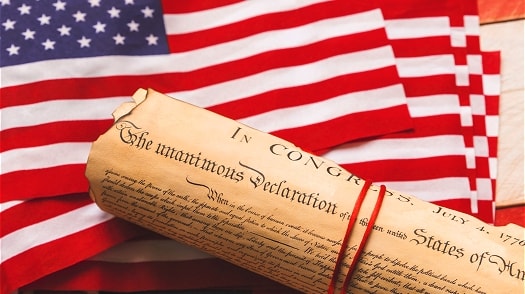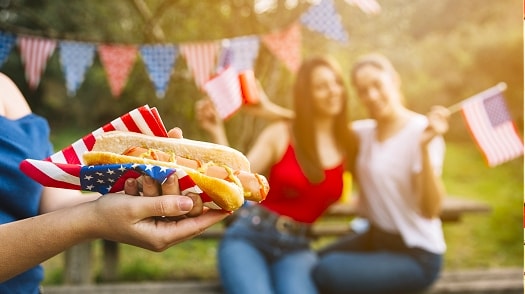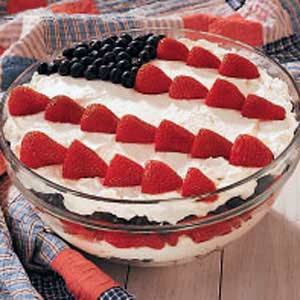July 4th American Independence Day

Independence Day, commonly known as the Fourth of July, is a federal holiday in the United States commemorating the adoption of the Declaration of Independence on July 4, 1776, declaring independence from the Kingdom of Great Britain. Independence Day is commonly associated with fireworks, parades, barbecues, carnivals, fairs, picnics, concerts, baseball games, family reunions, political speeches and ceremonies, and various other public and private events celebrating the history, government, and traditions of the United States. Independence Day is the national day of the United States.
During the American Revolution, the legal separation of the Thirteen Colonies from Great Britain occurred on July 2, 1776, when the Second Continental Congress voted to approve a resolution of independence that had been proposed in June by Richard Henry Lee of Virginia. After voting for independence, Congress turned its attention to the Declaration of Independence, a statement explaining this decision, which had been prepared by a Committee of Five, with Thomas Jefferson as its principal author. Congress debated and revised the Declaration, finally approving it on July 4. A day earlier, John Adams had written to his wife Abigail:
“The second day of July, 1776, will be the most memorable epoch in the history of America. I am apt to believe that it will be celebrated by succeeding generations as the great anniversary festival. It ought to be commemorated as the day of deliverance, by solemn acts of devotion to God Almighty. It ought to be solemnized with pomp and parade, with shows, games, sports, guns, bells, bonfires, and illuminations, from one end of this continent to the other, from this time forward forever more.”
Adams's prediction was off by two days. From the outset, Americans celebrated independence on July 4, the date shown on the much-publicized Declaration of Independence, rather than on July 2, the date the resolution of independence was approved in a closed session of Congress.
Historians have long disputed whether Congress actually signed the Declaration of Independence on July 4, even though Thomas Jefferson, John Adams, and Benjamin Franklin all later wrote that they had signed it on that day. Most historians have concluded that the Declaration was signed nearly a month after its adoption, on August 2, 1776, and not on July 4 as is commonly believed.
In a remarkable coincidence, both John Adams and Thomas Jefferson, the only signers of the Declaration of Independence later to serve as Presidents of the United States, died on the same day: July 4, 1826, which was the 50th anniversary of the Declaration. Although not a signer of the Declaration of Independence, James Monroe, the Fifth President of the United States, died on July 4, 1831. Calvin Coolidge, the Thirtieth President, was born on July 4, 1872, and thus was the only President to be born on Independence Day.
July 4th - National Holiday

Independence Day is a national holiday marked by patriotic displays. Similar to other summer-themed events, Independence Day celebrations often take place outdoors. Independence Day is a federal holiday, so all non-essential federal institutions (like the postal service and federal courts) are closed on that day. Many politicians make it a point on this day to appear at a public event to praise the nation's heritage, laws, history, society, and people.
Families often celebrate Independence Day by hosting or attending a picnic or barbecue and take advantage of the day off and gather with relatives. Decorations (e.g., streamers, balloons, and clothing) are generally colored red, white, and blue, the colors of the American flag. Parades often are in the morning, while fireworks displays occur in the evening at such places as parks, fairgrounds, or town squares.
Independence Day - Fireworks
Independence Day fireworks are often accompanied by patriotic songs such as the national anthem "The Star-Spangled Banner", "God Bless America", "America the Beautiful", "My Country, 'Tis of Thee", "This Land Is Your Land", "Stars and Stripes Forever", and, regionally, "Yankee Doodle" in northeastern states and "Dixie" in southern states. Some of the lyrics recall images of the Revolutionary War or the War of 1812.
Firework shows are held in many states, and many fireworks are sold for personal use or as an alternative to a public show. Safety concerns have led some states to ban fireworks or limit the sizes and types allowed. Illicit traffic transfers many fireworks from less restrictive states.
A salute of one gun for each state in the United States, called a “salute to the union,” is fired on Independence Day at noon by any capable military base.
In 2009, New York City had the largest fireworks display in the country, with over 22 tons of pyrotechnics exploded. Other major displays are in Chicago on Lake Michigan; in San Diego over Mission Bay; in Boston on the Charles River; in St. Louis on the Mississippi River; in San Francisco over the San Francisco Bay; and on the National Mall in Washington, D.C..
During the annual Windsor-Detroit International Freedom Festival, Detroit, Michigan hosts one of the world's largest fireworks displays, over the Detroit River, to celebrate Independence Day in conjunction with Windsor, Ontario's celebration of Canada Day.
While the official observance always falls on July 4th, participation levels may vary according to which day of the week the 4th falls on. If the holiday falls in the middle of the week, some fireworks displays and celebrations may take place during the weekend for convenience, again, varying by region.
The first week of July is typically one of the busiest American travel periods of the year, as many people utilize the holiday for extended vacation trips.
The most common Independence Day symbol is the American flag. Its design is displayed in all possible ways on July 4 and can be seen in front of homes and buildings. Other symbols associated with Independence Day are the Statue of Liberty on Ellis Island in New York and the fireworks viewed all over the United States. Sometimes large civic works such as the Erie Canal and the Washington Monument start on July 4, emphasizing their contribution to the economy and culture of the United States.
The Pledge Of Allegiance
“I pledge allegiance to the flag of the United States of America, and to the Republic for which it stands. One nation under God, indivisible, with liberty and justice for all.”
Independence Day Themed Dessert

Red, White And Blue Dessert Recipe
18 Servings Prep/Total Time: 20 min.
Ingredients
2 packages (8 ounces each) cream cheese, softened
1/2 cup sugar
1/2 teaspoon vanilla extract
1/2 teaspoon almond extract
2 cups heavy whipping cream, whipped
2 quarts strawberries, halved, divided
2 quarts blueberries, divided
Directions
In a large bowl, beat cream cheese, sugar and extracts until fluffy. Fold in whipped cream. Place a third of the mixture in a 4-qt. bowl. Reserve 20 strawberry halves and 1/2 cup blueberries for garnish.
Layer half of the remaining strawberries and blueberries over cream mixture. Top with another third of the cream mixture and the remaining berries. Spread the remaining cream mixture on top. Use the reserved strawberries and blueberries to make a "flag" on top. Yield: 18 servings.
Nutrition Facts: 1 serving (1 cup) equals 168 calories, 10 g fat (6 g saturated fat), 32 mg cholesterol, 44 mg sodium, 20 g carbohydrate, 3 g fiber, 2 g protein.
The Boston Pops Firework Spectacular
